Moong Dal Payasam / Pasi Paruppu Kheer is a flavorful and aromatic South Indian dessert made with yellow moong dal (mung beans). It is known for its simplicity and rich taste, this parupu payasam is a staple during festive occasions such as Pongal, Diwali, and Onam. The dessert combines the natural goodness of moong dal with the creamy texture of coconut milk and the subtle sweetness of jaggery, creating a perfectly balanced treat that’s both indulgent and nourishing.


Moong Dal Payasam Recipe
Paruppu Payasam / Moong Dal Payasam is a rich and traditional South Indian dessert flavoured with moong dal, coconut, and appropriately sweetened with jaggery. Its ideal for any special occasion. Kerala cuisine takes great pride in its iconic dessert, payasam, which was once served in royal palaces.
Jump to:
What makes Moong Dal Payasam stand out is its ability to be both light and filling at the same time. Much like Arisi Thengai Payasam or Sago Payasam, this dessert is often served as prasad during religious ceremonies, symbolizing prosperity and joy. Its comforting nature makes it perfect for sharing during family gatherings, marking special moments, or simply enjoying after a meal.
Whether served warm or chilled, Moong Dal Payasam is a timeless classic, loved for its smooth consistency and soothing flavors. Just like other beloved Payasams, such as Carrot Kheer or Mango Payasam, this dish brings a sense of warmth and tradition, making it a favorite in many households across the South. It’s a dish that transcends time, offering a taste of nostalgia with every spoonful.
Why I Make this on Special Occasions – There’s a unique joy in sharing Moong Dal Payasam with family and friends. I love watching everyone’s eyes light up when they take that first bite. It’s a simple dessert, but it brings people together, creating a sense of warmth and happiness around the table. Deep-Rooted Tradition: For me, making Moong Dal Payasam feels like carrying forward a tradition that’s been passed down through generations. It’s something my aunt used to make, and every time I prepare it, I feel connected to her. That sense of continuity makes the dish even more meaningful. It’s not just the taste, but the memories that come flooding back with each bite.
What is Moong Dal?
Pasi paruppu /Mung beans are known as Moong Dal in India. Mung beans are also known as green gramme or moong. In Indian cooking, both whole and split lentils are used. Mung bean husks are green in colour. When the husks are removed, the beans become yellow.


About Moong Dal Payasam
Moong Dal Payasam is a beloved dessert enjoyed across India, known by various names such as Pasi Paruppu Payasam, Moong Dal Kheer, Pesara Pappu Payasam, Moong Dal Sheera, and even Moong Dal Pudding in different regions.
I remember one Diwali evening from my childhood when the whole family gathered in the kitchen as my aunt prepared Moong Dal Payasam. We kids, with our eyes wide open, couldn’t wait for the first taste. The sweet aroma of moong dal cooking in coconut milk, along with the rich flavor of jaggery, filled the house.
I would sneak a taste every few minutes, just to catch a hint of that creamy sweetness. My aunt, with her gentle smile, would remind us that the joy of the dessert wasn’t just in the taste, but in the care and patience it took to prepare it. Whether it was called Pasi Paruppu Payasam or Moong Dal Kheer, that evening remains one of my fondest memories. The dish brought us together, and as we all sat down to enjoy it, there was an unspoken sense of connection and warmth, not just from the food, but from the shared traditions and love that went into making it.
Similar Payasam Recipes,
Rice Sago Kheer
Badam Kheer
Banana Payasam
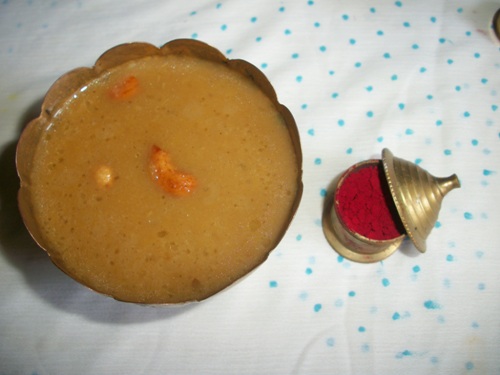

Why this Recipe works?
Nutrient-Packed: Unlike many desserts that rely heavily on refined sugar, moong dal offers a healthy source of protein, fiber, and essential vitamins. The coconut milk adds healthy fats, making this dessert not just indulgent but also nourishing.
Customizable: This recipe can easily be adjusted to suit different preferences. You can play with the sweetness level by adding more or less jaggery or even substitute it with sugar for a quicker version. The consistency can also be varied based on personal preference – thicker for a pudding- like texture or lighter for a more soup-like dish.
Versatility for Festive Occasions: Moong Dal Payasam is incredibly versatile and fits perfectly into various festive occasions like Pongal, Diwali, Onam, and Navratri, which makes it a go-to dessert for family celebrations. The dish is often prepared as prasad during religious ceremonies, symbolizing prosperity and good fortune.
Easy to Prepare: Despite its rich flavors and significance, this dessert is simple and quick to make. Whether you’re cooking it for a festive meal or just a comforting treat, the ingredients are easy to find, and the process is straightforward.
Perfect for Any Time of Day: Unlike many desserts that are reserved for after meals, Moong Dal Payasam can be enjoyed any time of the day. Whether it’s a quick breakfast treat, a sweet snack in the afternoon, or a comforting dessert after dinner, it always fits in. Its versatility means it’s never too early or too late to enjoy a warm bowl of Moong Dal Payasam.
Ingredients
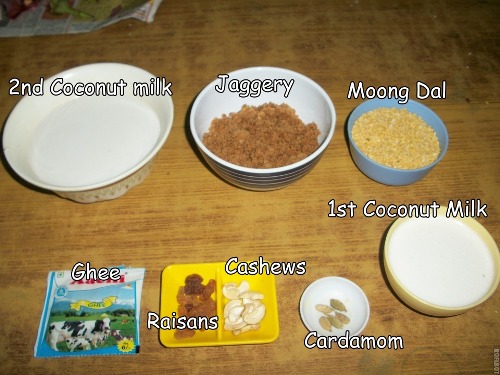

Yellow Moong Dal / Pasi Paruppu: The star ingredient in this recipe. Moong dal is a split yellow lentil that provides a creamy texture and a mild, nutty flavor. It’s commonly used in South Indian desserts for its light and easily digestible nature.
Jaggery: Jaggery is an unrefined sweetener made from sugarcane or palm sap. It offers a rich, deep sweetness and a subtle earthy flavor to the payasam. It’s a healthier alternative to refined sugar and also adds a boost of iron and minerals.
Ghee: Ghee is essential for roasting cashews and raisins. It brings a rich, nutty flavor and a smooth texture to the payasam. The aroma of ghee is an integral part of the dessert’s experience, adding depth and luxury.
Thin Coconut Milk (2nd Extract): Thin coconut milk acts as the base liquid, providing a light coconut flavor and helping to cook the moong dal. It adds subtle creaminess without being overly rich.
Thick Coconut Milk (1st Extract): This version of coconut milk is thicker and creamier, giving the payasam its luxurious, velvety texture. It enhances the coconut flavor and adds a rich, indulgent finish to the dessert.
Cashews: Cashews lend a delightful crunch to the payasam. When roasted in ghee, they also develop a toasty, nutty flavor that enhances the richness of the dish.
Kishmish / Sultanas: Raisins or sultanas add sweetness and chewiness to the payasam. They absorb the flavors of the other ingredients and provide a pleasant contrast to the creamy texture.
Cardamom: Cardamom is the key spice in this dessert, adding a warm, aromatic flavor that complements the sweetness of the jaggery.
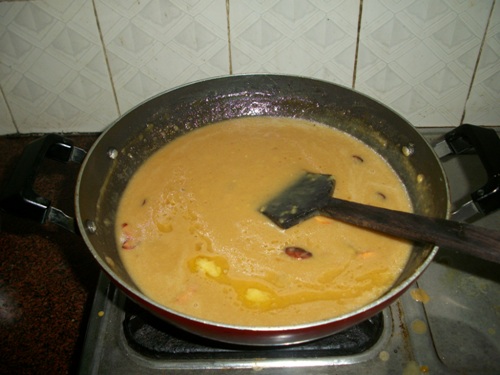

Hacks
- Lightly roasting the moong dal before cooking it enhances the flavor and gives the payasam a nutty aroma. It also helps to avoid a raw taste in the final dish.
- Soaking the moong dal for about 30 minutes before cooking helps it cook faster and more evenly, reducing the cooking time. This also helps in achieving a smoother texture in your payasam.
- For a rich and creamy texture, always opt for full-fat coconut milk. It gives the payasam a luxurious, velvety consistency that’s simply irresistible.
- For added depth of flavor, lightly roast the cardamom pods before crushing them. This will release their essential oils and intensify the flavor. You can also add a small piece of cinnamon or a pinch of nutmeg for a warm spice kick.
- Add Milk in Phases: Instead of adding all the milk at once, add it in phases. This helps in controlling the consistency and ensures the milk blends well with the moong dal without curdling.
- For a vegan-friendly version, replace ghee with coconut oil or any other vegetable oil, and use plant-based milk (like almond or oat milk) instead of coconut milk for a lighter, dairy-free version.
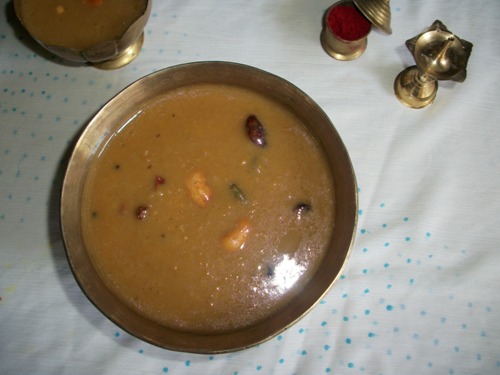

Moong Dal Payasam (Stepwise Pictures)
  |
| Take all your ingredients |
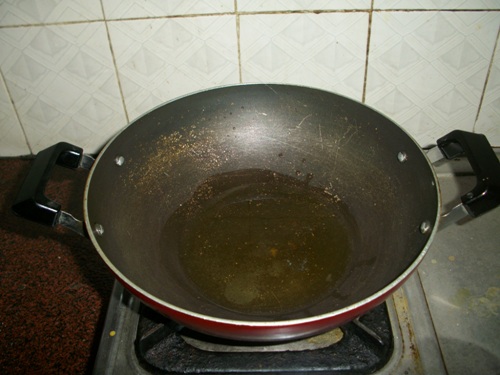  |
| Heat half of the ghee |
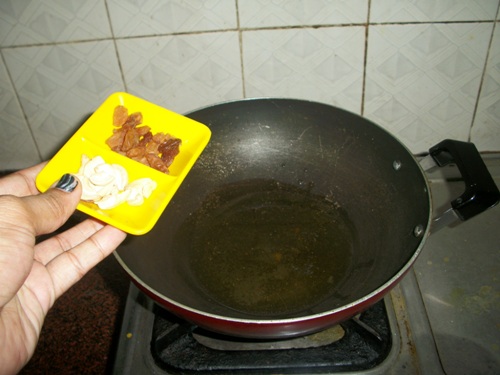  |
| add cashews and raisins |
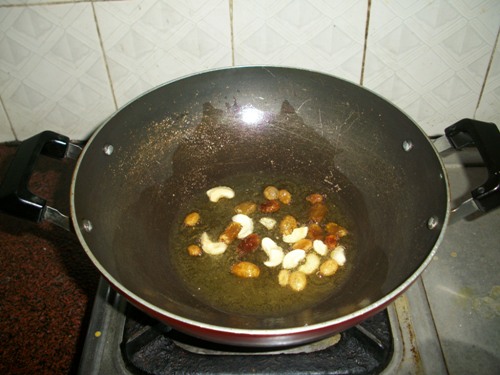  |
| and fry it |
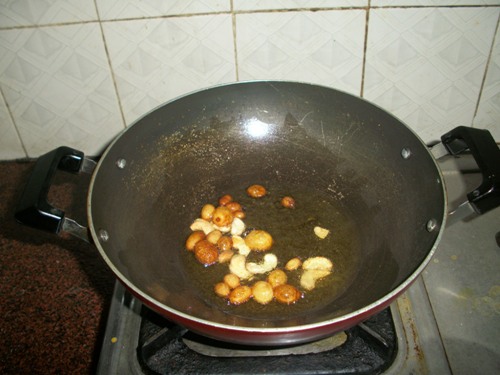  |
| fry till light golden |
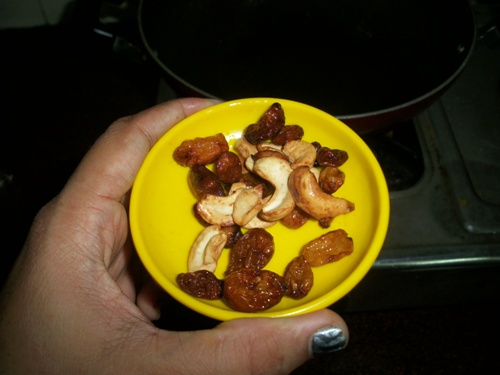  |
| remove it to a plate |
  |
| add moong dal in the remaining ghee |
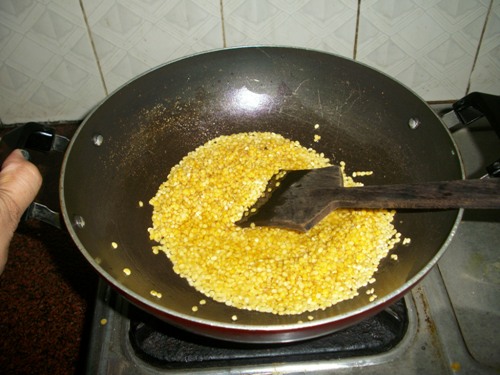  |
| and roast it |
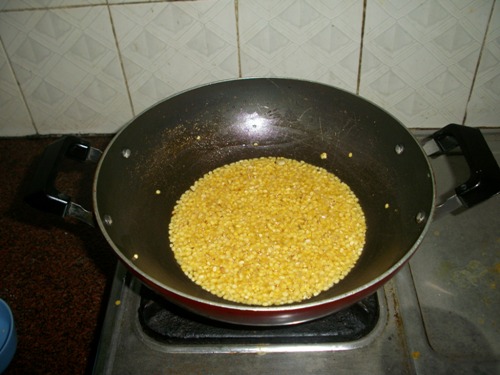  |
| till light golden |
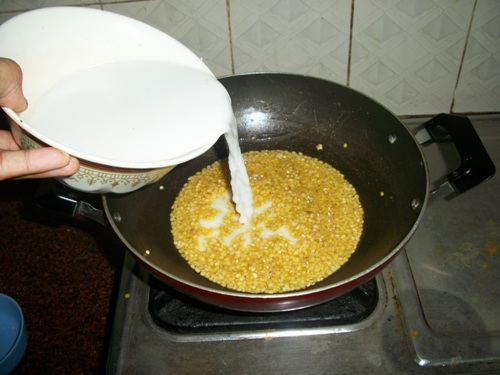  |
| add coconut milk (thin extract) |
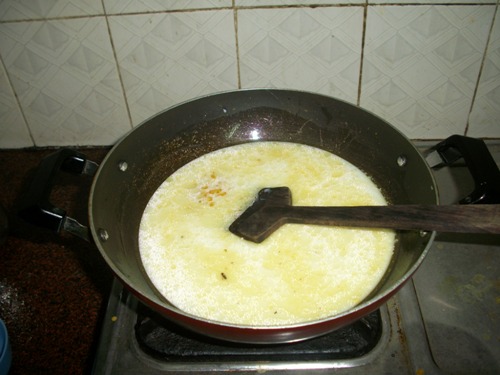  |
| and mix well |
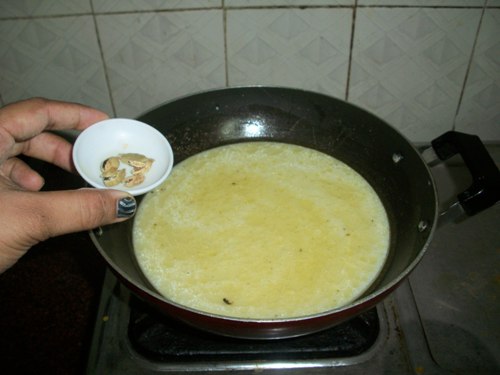  |
| add crushed cardamom |
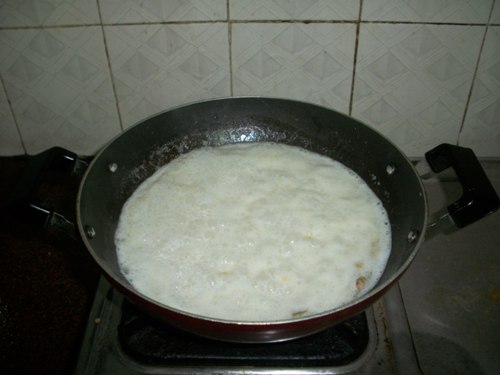  |
| bring it to a boil |
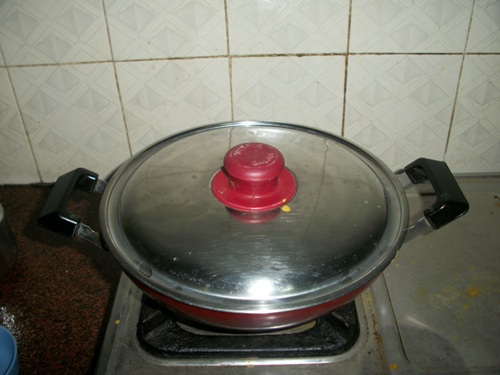  |
| cover and simmer |
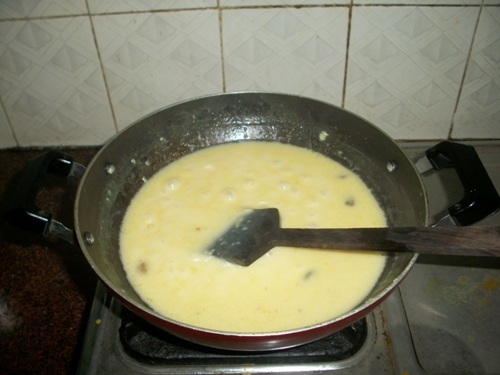  |
| until dal is cooked |
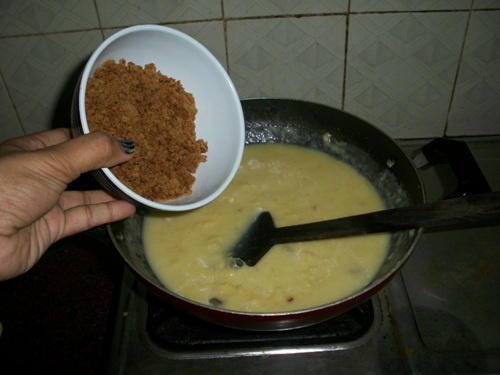  |
| now add in grated jaggery |
  |
| and mix well |
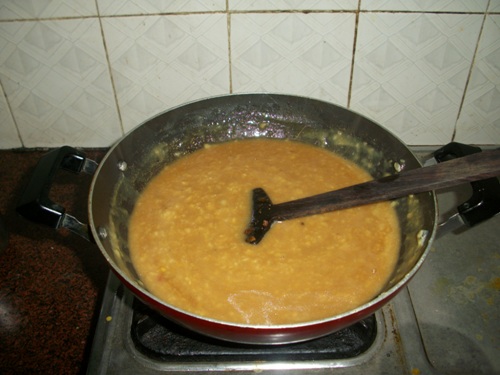  |
| now let it cook for few more mins |
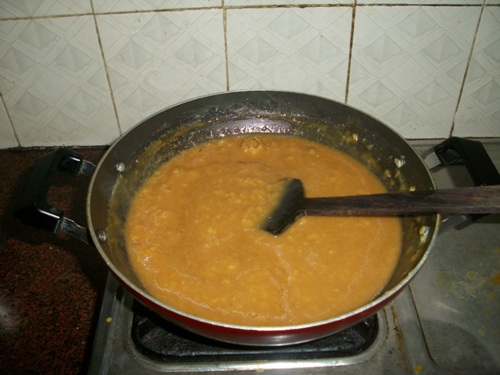  |
| all cooked |
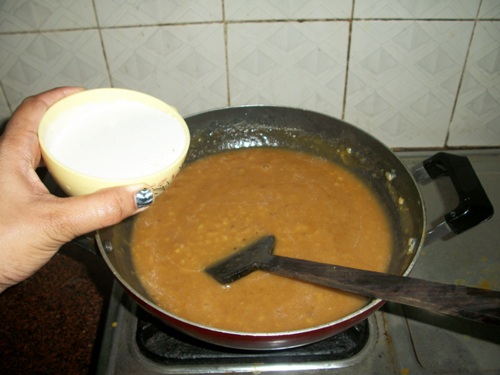  |
| switch off the flame(IMP) and add in thick coconut milk |
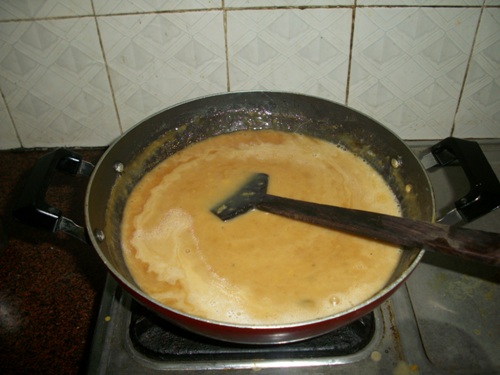  |
| and mix well |
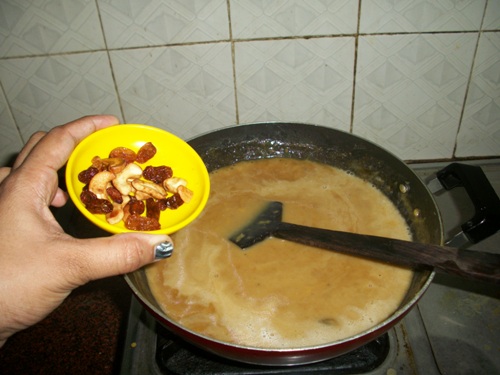  |
| add fried cashews and raisins |
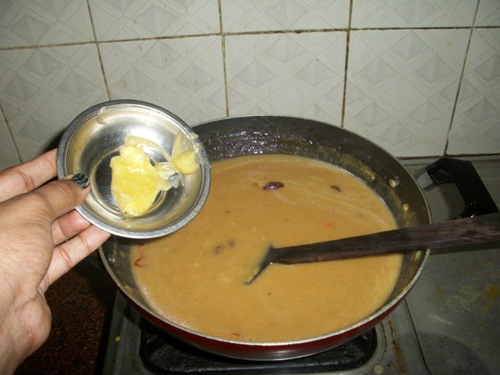  |
| and a tblspn of ghee |
  |
| and mix well |
  |
| Serve |
Expert Tips
Use a Heavy-bottomed Pan: A heavy-bottomed pan ensures that the payasam cooks evenly without the milk sticking or burning. It helps maintain the perfect texture, preventing any scorching.
Simmer Slowly for the Right Consistency: Cook the payasam on low heat and let it simmer slowly, stirring often. This allows the flavors to meld together and gives you the perfect creamy consistency. Avoid cooking on high heat, as it may cause the milk to curdle.
Add a Pinch of Salt: A tiny pinch of salt can enhance the sweetness of the jaggery and balance the overall flavor. It’s a simple trick that helps bring out the best in the payasam.
Serve Immediately or Chill: Moong Dal Payasam can be enjoyed both hot or chilled. If you’re serving it hot, ensure it is kept warm on low heat. For a refreshing twist, you can chill the payasam for a couple of hours before serving during hot weather.
Maintain the Right Heat While Adding Coconut Milk: When adding coconut milk, avoid boiling it on high heat, as it may cause it curdle. Instead, reduce the heat and stir continuously, allowing the coconut milk to blend smoothly with the rest of the ingredients.
Variations
Palada Payasam: A traditional Kerala dessert, Palada Payasam is made with palada (rice flakes) simmered in milk, sweetened with sugar, and flavored with cardamom. Its creamy texture and rich taste make it a popular treat during festivals and celebrations like Onam and Vishu.
Rava Payasam: Also known as Sooji Kheer. Rava Payasam is made with semolina, cooked in milk, and sweetened with sugar. Often enhanced with ghee, cashews, and raisins, it’s a comforting and quick dessert enjoyed during festivals such as Diwali and Navratri.
Beetroot Payasam: A healthy twist on the traditional dessert, Beetroot Payasam combines the earthy sweetness of beetroot with the richness of milk and jaggery. The vibrant pink color and distinct flavor make it a favorite among those looking to enjoy a unique variation of payasam.
Ragi Rava Kheer: Made with ragi (finger millet) and rava (semolina). Ragi Rava Kheer is a nutritious dessert often prepared with milk and jaggery. It’s a wholesome dessert, packed with calcium and iron, perfect for health-conscious dessert lovers.
Kodo Millet Kheer: Kodo millet is a gluten-free grain used to prepare a healthier version of kheer. Kodo Millet Kheer is made by cooking the millet in milk, sweetened with jaggery or sugar, and flavored with cardamom, offering a light yet flavorful dessert.
Badam Kheer: A rich and indulgent dessert, Badam Kheer is made with almonds ground into a smooth paste, cooked in milk, and sweetened with sugar or jaggery. The addition of cardamom and sometimes saffron gives it a luxurious flavor, making it a special treat for festive occasions.
FAQ
1. Can I make Payasam without milk?
Yes. You can make payasam without milk by using coconut milk or plant-based milk like almond milk or oat milk for a dairy-free version. This is especially useful for those following a vegan diet or lactose-intolerant individuals.
2. How can I store Payasam?
Payasam can be stored in the refrigerator for 2-3 days. Since it tends to thicken as it cools, you can add a little water or milk while reheating to bring it back to the desired consistency.
3. How do I make my Payasam thicker?
If your payasam is too runny, let it simmer on low heat until it thickens. You can also add ground nuts or a little extra semolina (for Rava Payasam) or lentils to achieve a thicker consistency.
4. Is Payasam healthy?
While traditional payasam is rich and indulgent, you can make it healthier by reducing the sugar content or using jaggery instead of refined sugar. Additionally, using whole grains like millets, ragi, or moong dal boosts the nutritional value of the dish, making it a wholesome dessert.
5. Can Payasam be made in advance?
Yes, you can prepare payasam a few hours in advance or even the day before. In fact, letting it rest enhances the flavor as the ingredients have more time to meld together. Just reheat gently before serving.
6. Why does my Payasam curdle?
Payasam can curdle if it’s cooked on high heat or if milk is added too quickly. To prevent this, always cook on low to medium heat and add milk gradually while stirring continuously.
7. Can I use sweeteners other than sugar?
Yes. You can use jaggery, honey, or palm sugar as alternative sweeteners for a more natural sweetness. These alternatives also add their unique flavors, enriching the taste of the payasam.
8. How do I make Payasam with a different flavor?
You can easily customize the flavor of your payasam by adding different spices like nutmeg, saffron, or rose water. For fruit-flavored payasam, adding mashed mango, banana, or papaya gives it a fresh twist.
9. What should I serve with Payasam?
Payasam is often served as a standalone dessert, but you can pair it with other traditional Indian sweets, snacks, or even serve it as part of a festive meal. For a savorier touch, some prefer to serve it with appam or idiyappam.
10. Can I make Payasam using rice?
Yes, rice is one of the classic ingredients used in payasam. Palada Payasam and Arisi Payasam (Rice Payasam) are examples of payasams made with rice, cooked with milk and sweetened with sugar or jaggery.
11. Is kheer and payasam same?
Kheer is known as payasam or payasa in southern India, which means milk. The difference between kheer and payasam is that payasam is typically made with jaggery and has a thinner consistency.
12. How is payasam served?
For centuries, payasam was served on a banana leaf as a side dish rather than at the end of a meal. Its still served just before the final course of curd in many homes.
13. What is the difference between payasam and Pradhaman?
Payasams are typically made with milk and a single boiling process, and are served at temples as part of the naivedya. Pradhamans are typically double-boiled and made with jaggery and coconut milk.
More Payasam (Kheer) Recipes
📖 Recipe Card
Moong Dal Payasam Recipe (Moong Dal Kheer)
Servings: 6 servings
Calories: 617kcal
Video


Nutrition
Serving: 1servings | Calories: 617kcal | Carbohydrates: 66g | Protein: 13g | Fat: 36g | Saturated Fat: 28g | Polyunsaturated Fat: 1g | Monounsaturated Fat: 4g | Cholesterol: 13mg | Sodium: 29mg | Potassium: 386mg | Fiber: 4g | Sugar: 39g | Vitamin A: 67IU | Vitamin C: 2mg | Calcium: 57mg | Iron: 6mg
If you have any questions not covered in this post and if you need help, leave me a comment or mail me @[email protected] and I’ll help as soon as I can.
Follow me on Instagram, Facebook,Pinterest ,Youtube and Twitter for more Yummy Tummy inspiration.
IF YOU MAKE THIS RECIPE OR ANYTHING FROM YUMMY TUMMY, MAKE SURE TO POST IT AND TAG ME SO I CAN SEE ALL OF YOUR CREATIONS!! #YUMMYTUMMYAARTHI AND @YUMMYTUMMYAARTHI ON INSTAGRAM!
More Dal Recipes
–>


